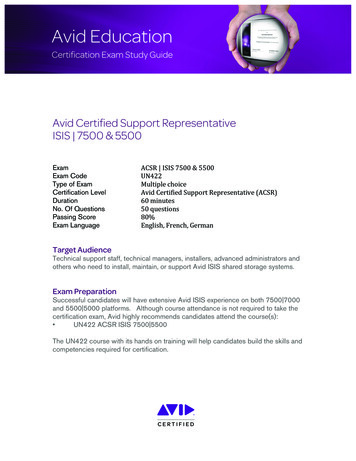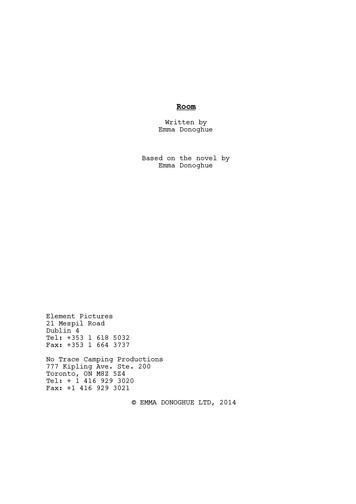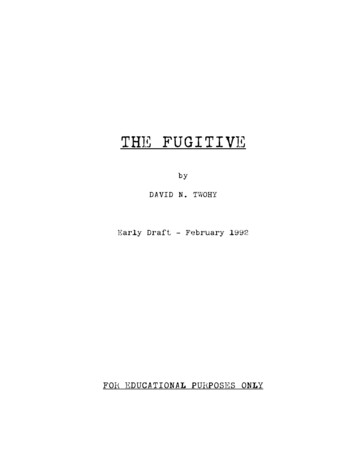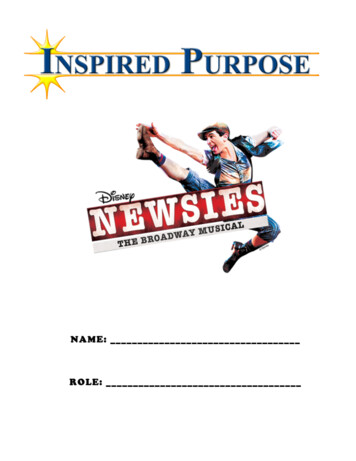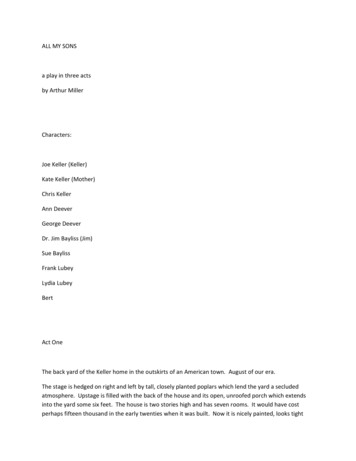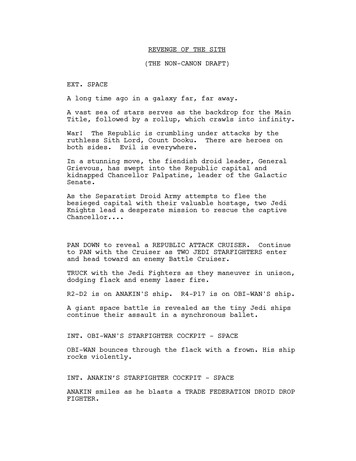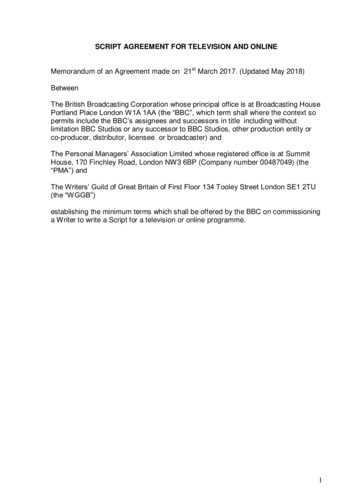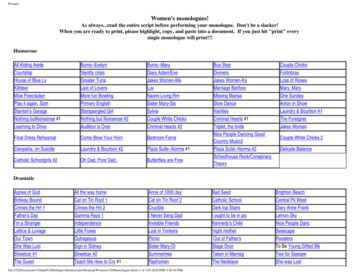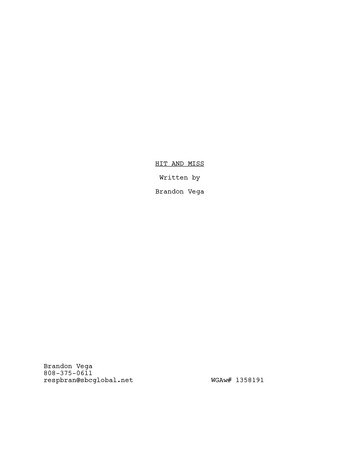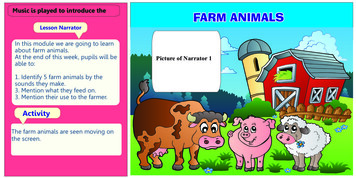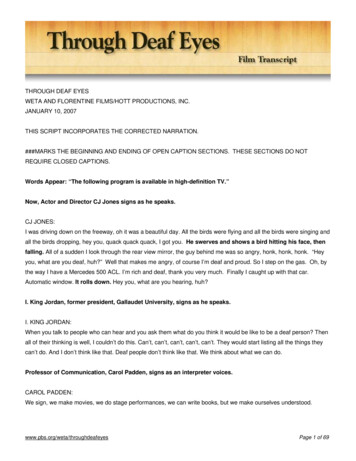
Transcription
THROUGH DEAF EYESWETA AND FLORENTINE FILMS/HOTT PRODUCTIONS, INC.JANUARY 10, 2007THIS SCRIPT INCORPORATES THE CORRECTED NARRATION.###MARKS THE BEGINNING AND ENDING OF OPEN CAPTION SECTIONS. THESE SECTIONS DO NOTREQUIRE CLOSED CAPTIONS.Words Appear: “The following program is available in high-definition TV.”Now, Actor and Director CJ Jones signs as he speaks.CJ JONES:I was driving down on the freeway, oh it was a beautiful day. All the birds were flying and all the birds were singing andall the birds dropping, hey you, quack quack quack, I got you. He swerves and shows a bird hitting his face, thenfalling. All of a sudden I look through the rear view mirror, the guy behind me was so angry, honk, honk, honk. “Heyyou, what are you deaf, huh?” Well that makes me angry, of course I’m deaf and proud. So I step on the gas. Oh, bythe way I have a Mercedes 500 ACL. I’m rich and deaf, thank you very much. Finally I caught up with that car.Automatic window. It rolls down. Hey you, what are you hearing, huh?I. King Jordan, former president, Gallaudet University, signs as he speaks.I. KING JORDAN:When you talk to people who can hear and you ask them what do you think it would be like to be a deaf person? Thenall of their thinking is well, I couldn’t do this. Can’t, can’t, can’t, can’t, can’t. They would start listing all the things theycan’t do. And I don’t think like that. Deaf people don’t think like that. We think about what we can do.Professor of Communication, Carol Padden, signs as an interpreter voices.CAROL PADDEN:We sign, we make movies, we do stage performances, we can write books, but we make ourselves understood.www.pbs.org/weta/throughdeafeyesPage 1 of 69
##OPEN CAPTIONS BEGIN ###TEACHER:Say the word airplane.A teacher shows a cartoon-plane. A white-gloved hand glides forward, like a plane flying. A home-made flyingmachine falls over. A girl responds to the teacher.LITTLE GIRL:Airplane.Now, the band “Beethoven’s Nightmare” plays “It’s Just a Deaf Thing.” A woman dances as she signs lyrics.NARRATOR:Let's take a quiz. Ready? True or False: The performer waves her hands. All deaf people use sign language. Signlanguage is universal. Deaf people live in a silent world. Having a deaf child is a tragedy. All deaf people would liketo be cured. Signing “I love you,” audience members pulse their bodies. Hint: The answers are all going to befalse.As the band plays, a young girl prances across the stage.[SHORT PAUSE] Now, colorful circles radiate and overlap. A title: “Through Deaf Eyes.”##OPEN CAPTIONS END ###TITLE: THROUGH DEAF EYESNow, Professor of ASL and Deaf Studies Samuel Supalla signs as an interpreter voices.SAM SUPALLA:There was a little girl, a neighbor girl that came over and played with me. And we used gesture with each other. Onetime I went over to visit her, and I saw her using her lips to communicate with her mother. They weren’t using theirhands at all. And so I ran home and I asked my mother what was happening. Why aren’t they using their hands? Mymother said, “they’re hearing.” And I said, oh, well what are we? She said, “Daddy and I are deaf. You’re deaf, yourwww.pbs.org/weta/throughdeafeyesPage 2 of 69
brothers are deaf.” And I said, is everyone deaf? Is that little girl the only hearing girl in the world? She said, “No,everyone else is like them.” And I said, oh, now I get it.A title: “Graduation. The Clarke School for the Deaf.” Teenage-boys wearing suits and girls in party-dressesexchange hugs. Some wear hearing-aides.NARRATION:Deafness is almost always one generation thick. Over ninety percent of all deaf people have parents who can hear.And most deaf parents have children who can hear. So deaf people interact on a meaningful and intimate level withhearing people all their lives. Yet most Americans have very little understanding of what it means to be deaf.Actress Marlee Matlin signs as an interpreter voices.MARLEE MATLIN:I was doing an interview once with CNN. And the woman and I were getting ready, getting our makeup ready. And Imean this is live in front of millions of people. And I was ready to be interviewed. And everybody was in their positions.And with three seconds before the light was to come on the camera, the interviewer needed my attention and she saidMarlee, “My dog is deaf like you.” And the next thing I know the light is on the camera. And there I am live. And I’mthinking in the back of my head, does she want to throw me a bone? Does she want me identify with her dog? I hadno idea what the significance of that was.Teacher Rory Osbrink signs as an interpreter voices.RORY OSBRINK:People need to realize that we’re normal. Don’t just look at my ear. Don't look at it is as a physical handicap. We’renormal really. Yes, we do have some accommodations to be made to survive in a society where it’s dominated byhearing people. But at the same time if you were to come into the room and it would be full of deaf people, then youwould need the accommodation too.A title: “Reunion, The Clarke School for the Deaf.”NARRATION:Thirty-five million Americans are hard of hearing to some degree. Of these, an estimated 300,000 people areprofoundly deaf. Deaf people can be found in every ethnic group, every region, every economic class. Two womenwww.pbs.org/weta/throughdeafeyesPage 3 of 69
hug. Some deafness is hereditary; some is caused by illness or accident. To be deaf is to be part of a tiny minority in ahearing world, but it is far from the uniform and tragic experience that most hearing people imagine.Math Professor David James.DAVID JAMES:Being deaf is, well, it’s part of me. It’s something I have to deal with but it doesn’t keep me from being happy. It doesn’tmake me either happy or sad. It’s just like being a man instead of a woman or being tall instead of short.Professor of ASL and Deaf Studies Carolyn McCaskill signs as an interpreter voices.CAROLYN MCCASKILL:Maybe a person can’t see and is that normal? Maybe it is. And maybe a person walks with a bit of a limp. Perhapsthat’s normal to one person and not to another. What about left-handedness? Is that abnormal or is that normal?Superintendent James E. Tucker, Maryland School for the Deaf, signs as an interpreter voices.JAMES TUCKER:We have two children. We have Bradford here who’s probably the only kid in town who can talk on the phone and playbasketball at the same time. Holding a cell-phone to one ear, a teenager dunks a basketball. He is our onlyhearing child. He has to sign all the time because there’s no one else in the family who is hearing.Karen Sheffer-Tucker signs as an interpreter voices.KAREN SHEFFER-TUCKER:Our daughter’s eleven. She’s deaf. We have just the two, and we don’t want anymore. We have a boy and a girl andthat’s enough for us. I guess we’re the all-American family. Just the four of us. It’s a nice number.NARRATION:Today it's entirely possible for a deaf family to call itself an all-American family, but that isn't how the story begins. Forcenturies hearing people saw deafness as a horrendous misfortune. When a Protestant revival swept through 19thcentury America, fervent Christians labored to bring the gospel to unbelievers. But one group of souls seemed lockedaway forever from the word of God.www.pbs.org/weta/throughdeafeyesPage 4 of 69
Historian Douglas Baynton signs as an interpreter voices.DOUG BAYNTON:Most of the deaf people in America in the early 1800s lived in rural areas. They were separated from each other, theywere isolated. Most had very little communication with the people around them. Deaf people had a limitedunderstanding of what they could do – of their own possibilities. And people with deaf children really had no idea ofwhat their children could achieve.Trees stand in silhouette against a golden sky.NARRATION:Very few Americans believed that deaf people could be educated at all – until 1817, when a Connecticut clergymannamed Thomas Hopkins Gallaudet discovered his mission in life: to bring the Gospel to people who could not hear. InHartford, he opened the first permanent school for deaf children in America, with just seven students – and a headteacher from France who is now a legend in the Deaf community.JOHN VICKREY VAN CLEVE:Laurent Clerc was a teacher at the Paris Institution for the Deaf. And he was an extremely well-educated, sharp, wittyman, who was very, very deaf, and had been very, very deaf since infancy. Carved wooden hands form the letters:“D.E.A.F.” One of the things that Clerc brought to the United States was French sign language.NARRATION:Laurent Clerc taught using his hands: he communicated with sign. To Gallaudet, the language was a revelation. Hecalled it "highly poetical." Carved hands spell alphabet. To Clerc, and to many deaf people, signing was natural, andpractical.Historian John Vickrey Van Cleve.JOHN VICKREY VAN CLEVE:Clerc discovered that there were already some signs in use by some of his students. Clerc took his native French signlanguage and he blended it with a little bit of the signs that he saw students using here in the United States.www.pbs.org/weta/throughdeafeyesPage 5 of 69
NARRATION:The result was an American sign language that spread west and south as new schools for deaf children opened. Inarchival photos, students pose for the camera. New York, Pennsylvania, Virginia, Ohio, Kentucky, Tennessee,Indiana, Illinois. In 1864, Abraham Lincoln signed a law founding the first college in the world for deaf students –eventually it would be called Gallaudet University. And all these schools used sign.Now, a black-and-white film.ARCHIVAL FILMALEXANDER GRAHAM BELL:My dear sir, the organs of speech are in no way effected by deafness. The deaf person is mute simply because hecannot hear, and hasn’t been taught to speak.A contradiction in terms sir, a most illogical contradiction, the deaf mute's speech organs may be intact NARRATION:In April, 1871, a bright young Scottish immigrant, Alexander Graham Bell, began teaching deaf children in Boston.Like Gallaudet, he had a passion and a mission: to bring language to deaf people.ARCHIVAL FILMALEXANDER GRAHAM BELL:Nature inflicted upon the deaf child but one flaw. One little flaw, imperfect hearing. But we deny him speech by notteaching him to speak.BRIAN GREENWALD:Society in general views Alexander Graham Bell as an American hero, as the inventor of the telephone. He wasfamous, wealthy, and influential. His wife was deaf. His own mother was deaf. He was always associating with theDeaf community. Historian Brian Greenwald signs. He was a teacher of deaf children at a day school in Boston. Hewas very familiar with the deaf world.Author Tom Humphries signs.TOM HUMPHRIES:www.pbs.org/weta/throughdeafeyesPage 6 of 69
Alexander Graham Bell is a very important figure in Deaf folklore. He offers an antagonist perspective because he’slike the boogie man. Humphries fingerspells the word “boogieman.” An interpreter voices. And even though he’sa great man in his own right, but he did put forth the idea that a life without signing, would be a better life.In a photo, children sign different letters.DOUG BAYNTON:Bell thought that signing prevented deaf people from learning to speak, so he was against deaf people using sign, theirnatural language. Douglas Beynton mouths words as he signs. An interpreter voices. Bell believed that signlanguage marked them as different and kept them in the lower classes. He believed that earlier in the 1800s signlanguage had been their only recourse. But now there’s a better choice, the technology to teach them to speak and lipread. The oral method.K. Todd HoustonK. TODD HOUSTON:Bell thought, over a hundred years ago, that if every deaf child who received the right type of education and the use ofthe right technology, that those children could learn to use spoken language.NARRATION:Oral schools for deaf children opened in the late 1860s. They did not teach sign and, in fact, outlawed its use. Insteadthey began speech training,teaching deaf children to generate sounds, to mimic the mouth shapes and breathingpatterns of speech. And if children knew what speech looked like, the oralists thought, they could learn to read lips.This was an idea that divided educators of deaf children, and it still does today. BEGIN OPEN CAPTION ###Here'sone man’s take on lipreading, from Audism, by deaf filmmaker Rene Visco.Now, different telephones flash by. Captions appear as a young man mouths his words: “Can you read lips?CAN YOU READ LIPS?” A montage shows telephones and the human ear.MAN (SIGNING) –Can you read lips? CAN YOU READ LIPS?Almost all hearing people I meet can’t read lips. I know they can’t. Yet they will judge deaf people on our ability toREAD LIPS. If I want to read lips, I’ll go to my girlfriend.www.pbs.org/weta/throughdeafeyesPage 7 of 69
A montage: Men and women talk on the phone.END OPEN CAPTIONS###Now, Carol GarretsonCAROL GARRETSON:Oh, do you lip read? That’s a very dangerous question because if you say yes they blah-blah-blah. Whoa, wait, wait aminute. No, you have to go slower, then – Carol’s mouth gapes open. No, no, no, no, no. Just talk normally.GENEVIEVE JAMES:It was a bit hectic. We didn’t really have a lot of time to prepare. But it’s a take home. I meanwe had all this homework and quizzes and stuff so I just lucked out.Genevieve and David James.DAVID JAMES:Did you take a look at it?DAVID JAMES:I can understand people who speak directly to me in good light. And without too much background noise. And a lot ofwhat I do in speaking is arranging these circumstances. And if that doesn’t happen, I don’t hear things. I can be part ofthe conversation without knowing what the other people are saying.A photo shows children in a classroom.NARRATION:Speaking, lip reading and participation in "normal" conversation was, from the beginning, the great goal of the oralistmethod. In 1880, the method was endorsed by an important international conference of educators in Milan, Italy.Oralism was beginning to win.Carol
THIS SCRIPT INCORPORATES THE CORRECTED NARRATION. . As the band plays, a young girl prances across the stage. [SHORT PAUSE] Now, colorful circles radiate and overlap. A title: “Through Deaf Eyes.” ##OPEN CAPTIONS END ### TITLE: THROUGH DEAF EYES Now, Professor of ASL and Deaf Studies Samuel Supalla signs as an interpreter voices. SAM SUPALLA: There was a little girl, a neighbor girl
